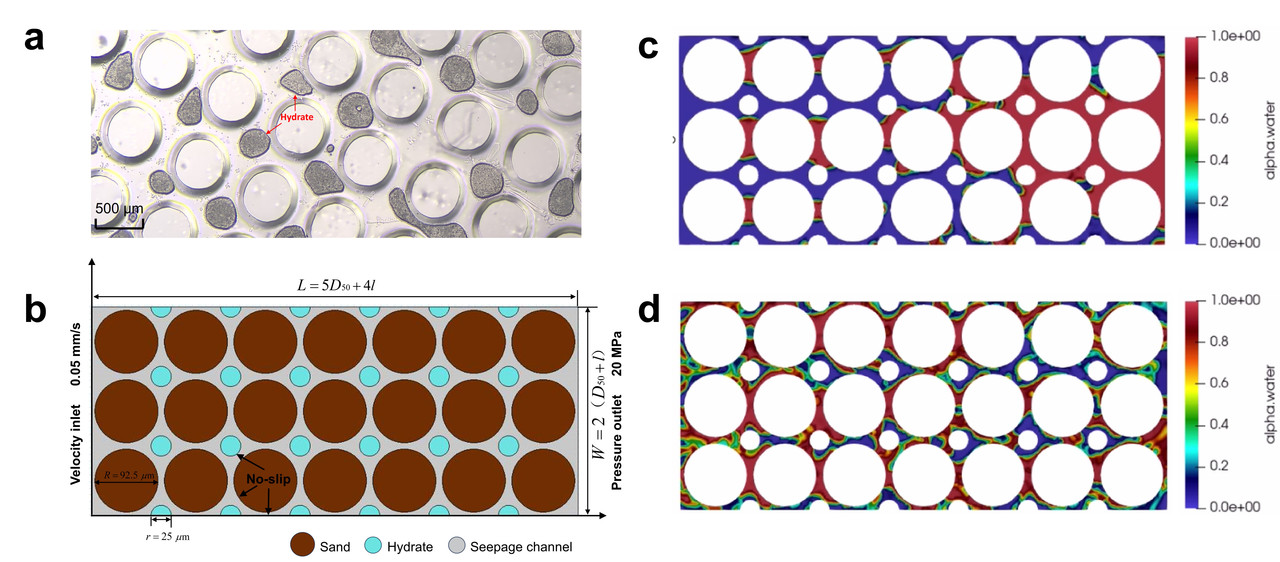Speaker
Description
Natural gas hydrates (NGH) are considered as the future clean energy in the era of carbon neutrality 1. Seepage behaviour of gas-water flow in hydrate-bearing sediment (HBS) and its controlling factors is significant for developing effective production strategies. The flow patterns and relative permeability are two crucial aspects of the study on two phase flow in HBS, which are influenced by various factors involving pore structure, wettability, hydrate morphology, and fluid properties. Currently, most research is focused on macroscopic permeability, with limited exploration of the flow patterns of gas and water in the presence of hydrates. Additionally, due to the distinct physical properties of hydrate particles such as wettability and phase change [2, 3], experimental methods struggle to observe the interactions between multiphase fluids and the skeleton (sediment + hydrates). Accurate determination of relative permeability is also challenging [4]. This study aims at investigating the characteristics of gas-water flow in the presence of hydrates and constructing an improved method for determining relative permeability based on CFD methods. In microfluidic chip experiments, the morphology and heterogeneous distribution of hydrates, gas-water flow rates, and the wettability of the skeleton were observed. Based on the information obtained from experiments, a geometric model of HBS is constructed. Subsequently, Volume of Fluid (VOF) algorithm using OpenFOAM is applied for simulating two-phase gas-water flow. A steady-state method based on experimental determination of relative permeability was applied to construct gas-water relative permeability curves in numerical simulations.
Fig. 1a presents the observation of pore-scale hydrate morphology and spatial distribution on the microfluidic chip. Hydrate particles with size range of 5- ~500 μm were observed to form within the pores, indicating a pore-filling type. Fig. 1b is the generated numerical model of HBS. Fig. 1c-d shows the CFD simulation of gas-water flow behaviours in HBS. The influence of hydrate saturation and contact angles on the dynamic distribution of gas and water in pores were investigated. When the water-particle contact angle is small, the gas phase displacement exhibits a fingering pattern, forming distinct preferential flow channels. As the contact angle increases, the gas phase transitions into a discontinuous state, causing some water to be retained within the pores. Fig. 2a depicts the variation of water saturation and inlet-outlet pressure drop over time with steady-state method. Various water saturation are achieved by setting different ratios of inlet gas to water flow rates until reaching the final stable state. The effective permeability of gas and water is then calculated according to Darcy's law (as shown in Fig. 2b).

Fig. 1. (a) CH4 hydrate morphology and spatial distribution on the microfluidic chip. (b) Generated numerical model of HBS. (c-d) gas-water flow patterns in simulations.

Fig. 2. (a) water saturation and (b) inlet-outlet pressure drop over time. (c) gas-water relative permeability curve.
| References | [1] Z. Yin, P. Linga, Methane hydrates: A future clean energy resource, Chinese Journal of Chemical Engineering, 27 (2019) 2026-2036. [2] J. Zhang, X. Liu, D. Chen, Z. Yin, An investigation on the permeability of hydrate-bearing sediments based on pore-scale CFD simulation, International Journal of Heat and Mass Transfer, 192 (2022). [3] J. Zhang, Z. Yin, Q. Li, S. Li, Y. Wang, X.-S. Li, Comparison of fluid production between excess-gas and excess-water hydrate-bearing sediments under depressurization and its implication on energy recovery, Energy, 282 (2023) 128315. [4] G. Gong, G. Zhao, W. Pang, M. Yang, B. Chen, J.-n. Zheng, Review of hydrate-bearing sediment permeability for natural gas hydrate exploitation: Measurement and application development, Journal of Petroleum Science and Engineering, 220 (2023) 111217. |
|---|---|
| Country | China |
| Conference Proceedings | I am interested in having my paper published in the proceedings. |
| Student Awards | I would like to submit this presentation into both awards |
| Acceptance of the Terms & Conditions | Click here to agree |




.jpg)
